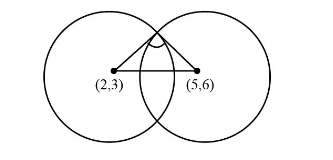
Two circles of equal radii
A.
B.
C.
D.
Answer
480.9k+ views
Hint: Since the two circles cut orthogonally it follows the formula that sum of the square of the first radius and square of the second radius is equal to the square of the distance between the centres of the circle. Use the property that the radius is equal for both circles.
Complete step-by-step answer:
Given that the circles cut orthogonally.
Given that the radius of the circles are equal.
Given the centres of the circles are

Now if the two circles are orthogonal to each other then the tangent of the first circle at the intersection point of the circle touches the other circle. So the tangents of the two circles form the right angled triangle where the base is the radius of one circle and height is the radius of the other circle and hypotenuse is equal to the distance between the centres of the circles.
Since the triangle is right angle triangle it follows Pythagoras theorem,
Let us consider base as
So after substituting (1) we get,
We know the radius is equal then we will take
On substitute the value in (2) we get,
The hypotenuse is equal to the distance of the two centres.
To find the distance between two points as
We know the distance between the two points is,
The distance between
Hence, the hypotenuse is
Then on substitute the values in (3) we get,
Hence, we get the value of radius as
Therefore, the radius of the circle is
So, the correct answer is “
Note: Here, in this problem we have taken radius as
Complete step-by-step answer:
Given that the circles cut orthogonally.
Given that the radius of the circles are equal.
Given the centres of the circles are

Now if the two circles are orthogonal to each other then the tangent of the first circle at the intersection point of the circle touches the other circle. So the tangents of the two circles form the right angled triangle where the base is the radius of one circle and height is the radius of the other circle and hypotenuse is equal to the distance between the centres of the circles.
Since the triangle is right angle triangle it follows Pythagoras theorem,
Let us consider base as
So after substituting (1) we get,
We know the radius is equal then we will take
On substitute the value in (2) we get,
The hypotenuse is equal to the distance of the two centres.
To find the distance between two points as
We know the distance between the two points is,
The distance between
Hence, the hypotenuse is
Then on substitute the values in (3) we get,
Hence, we get the value of radius as
Therefore, the radius of the circle is
So, the correct answer is “
Note: Here, in this problem we have taken radius as
Latest Vedantu courses for you
Grade 11 Science PCM | CBSE | SCHOOL | English
CBSE (2025-26)
School Full course for CBSE students
₹41,848 per year
EMI starts from ₹3,487.34 per month
Recently Updated Pages
Master Class 9 General Knowledge: Engaging Questions & Answers for Success

Master Class 9 English: Engaging Questions & Answers for Success

Master Class 9 Science: Engaging Questions & Answers for Success

Master Class 9 Social Science: Engaging Questions & Answers for Success

Master Class 9 Maths: Engaging Questions & Answers for Success

Class 9 Question and Answer - Your Ultimate Solutions Guide

Trending doubts
Fill the blanks with the suitable prepositions 1 The class 9 english CBSE

Difference Between Plant Cell and Animal Cell

Given that HCF 306 657 9 find the LCM 306 657 class 9 maths CBSE

The highest mountain peak in India is A Kanchenjunga class 9 social science CBSE

What is the difference between Atleast and Atmost in class 9 maths CBSE

What is pollution? How many types of pollution? Define it




